Heading out the door? Read this article on the new Outside+ app available now on iOS devices for members! Download the app.
We focus so much on the act of climbing and what gear is essential in that arena—rock shoes, harness, rope, hardware, helmet, pack—that we sometimes neglect what’s helpful for actually getting to the climb. The approach can be anything from a short scramble to the crag or a multi-day hump to a valley of granite towers and anything in between. No matter what, the best approach shoes combine the stability and support of a hiking boot with the grip and dexterity of a climbing shoe.
Building a quality approach shoe is an art—and a science. Manufacturers take wildly different materials and delicately press, weld, glue, or sew them together into a cohesive unit that should get you from your car to your climb as efficiently as possible. Before purchasing a pair of approach shoes, it’s important to have a basic understanding of the materials keeping you stuck to the stone:
- Outsole: Lugs (the knobs on the sole of the shoe) dig into the dirt for grip on trails. Some approach shoes have a shallow dot pattern that creates more contact between the rock and rubber, so they smear better on slabby stone.
- Midsole: This is the main shock absorber that decreases impact on the trail. Two common materials are polyurethane foam (PU) and ethylene vinyl acetate foam (EVA). PU is dense and strong, with a longer lifespan than EVA, but it isn’t quite as soft. EVA is lighter and cushier but less durable.
- Drop: This refers to the difference in “stack height” (the measurement of material between the bottom of your foot and the ground) at your heel and forefoot. The smaller the drop, the more minimalist the shoe, and the more you’ll feel the ground beneath your feet, which helps for approaches that demand precise scrambling and technical movement. Hiking boots and traditional trail runners have a higher stack heights and drop, which provides more cushioning and support for heavy loads.
- Forefoot Plate: This higher-density foam or plastic piece provides additional support and protection for the ball of your foot.
- Heel Wedge: This midsole component, usually a softer foam, absorbs impact during initial heel strike to provide a more comfortable ride.
- Upper: This is the top part of the shoe that adds support and guards your foot from outside threats. The upper can be synthetic, leather, mesh, or some combination to offer varying degrees of water resistance, breathability, and insulation.
- Footbed: Also called the insole, it sits directly beneath your foot. This foam insert comforts and supports, molding to your foot’s unique shape. If you really love a shoe, but need more arch support, for example, try an after-market insole.
How to size your approach shoes
It’s easy to obsess over the climbing ability of a shoe while ignoring how it hikes. However, remember that you’ll probably spend much more time hiking in your shoes than you will climbing. Size your shoes to be moderately comfortable on a five-mile hike, while ensuring that you can cinch up the laces for a tighter fit on your climb. Your toes should not reach the end of the shoe, but neither should they be swimming in an overly spacious toe box.
How to increase your approach shoes’ life
Delamination, one of the most common durability issues, is the breakdown of the glue between the outsole and the midsole. Most shoe layers are bonded with an adhesive, typically a heat-activated glue held together by strong chemical bonds. The number-one cause of delam is heat, so don’t leave your shoes baking in your car between climbing trips or in direct sunlight. And, as tempting as it is, don’t put your feet up right next to the campfire or leave your shoes next to it to dry. However, if you experience a wagging rubber tongue coming off the toe soon after purchasing or without much wear, it could be due to ineffective contact between the glue and rubber, which is an error that occurs during manufacturing (usually from not having the two surfaces perfectly clean when gluing). Contact the company directly to get them repaired or replaced.
Our favorite approach shoes
 La Sportiva TX Guide
La Sportiva TX Guide
The La Sportiva TX Guide is among the best rock-climbing approach shoes one of our testers has ever worn, “and I don’t say that lightly,” he writes. “They are responsive, precise, and comfortable.” La Sportiva describes them as a middle ground between trail runner and stiff climbing boot, and while they are certainly a supportive hiker, we find them a bit too cumbersome to throw out our running shoes for rest-day jogs. They are stiff through the midsole, yet the four-millimeter Ortholite insole and high-cushioned heel are still nice and springy. Hiking to a climb, this combination of stiffness and cushioning means that—whether hopping between rocks or accelerating on the flats—you always feel steady, while the shock absorption coddles your joints.
Price: $159
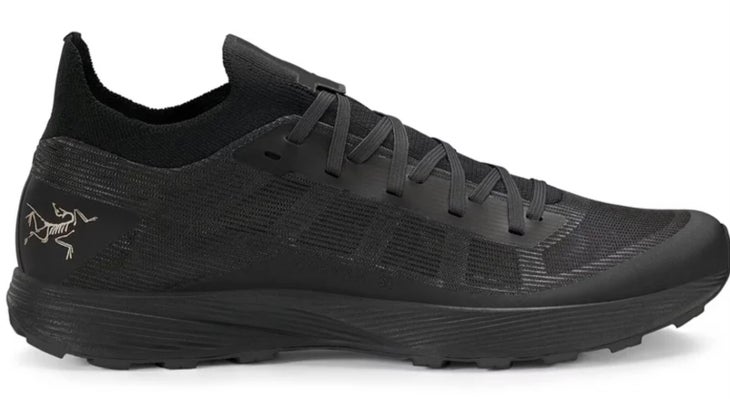
Arc’teryx Norvan SL 3
I remember when my parents bought me my first pair of racing flats in high school track, I felt like I could fly. Slipping on the Norvan SL was the same experience but for the backcountry. The Megagrip outsole is as sticky as you can get without actual climbing rubber (which has the downfalls of being heavier and less durable), and the ultralight mesh upper cradles with a sock-like fit. Meanwhile, a moderate drop and low stack height keep you nimble on the trails without rolling ankles. But rack up with the SL clipped to the back of your harness and its true singularity shines: they weigh practically nothing. Of course everything comes with pros and cons, and the ultralight nature means they won’t protect your feet particularly well in rugged talus, and perform ten Hail Mary’s (at least) if you have to kick steps in firm snow; but for big climbing objectives where you’ll be sending with them primarily on your harness/in the pack on your back they are unmatched.
While the mesh upper construction defines “minimal,” the underfoot is surprisingly protective—more so than a TX2 for reference. Initially they seemed like a superlight choice (6oz/ 170g) suited only for short approaches on the smooth trails of Eldorado Canyon or the like. However, pushing the bounds bit by bit, the Norvan SL failed to come up short and soon I found myself wearing them on huge linkup days in Leavenworth’s Enchantments where they cruised the long approaches (*bonus, they also dried quickly from mushy snowfield crossings). They even proved worthy for up-n-overs in Rocky Mountain National Park where the terrain is less forgiving but the tradeoff was well worth the reduced weight for long simul blocks and 5.12 cruxes. Ultimately comes the key crucible for any approach/trail runner: scrambling the 1st Flatiron in Boulder, CO, a 1,000-foot fin of sandstone slab up to 5.6 in difficulty. Result: flying colors. For objectives where you’re carrying everything up and over—and you won’t be traveling gnarly talus or bushwacking—the Norvan SL are an indispensably unique shoe in the multi-pitch climber’s quiver.
Price $160
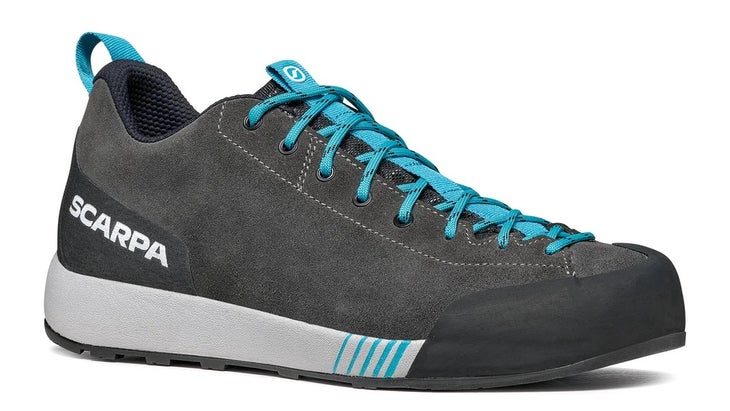
Scarpa Gecko
Scarpa’s most technical, climbing-focused approacher was re-tooled for spring 2021, with an updated color palate and about 2 ounces of weight savings per shoe. Like the original Gecko, they have a soft, intuitive, natural feel on technical terrain—you can dig into fairly small footholds (up to 5.10/5.11 jibs and crimps), the sticky rand/toecaps are stable in big cracks, and, with lots of forefoot flex, the Geckos smear extremely well. On the technical side, the new Geckos score the same high marks as their predecessors; they truly are top tier for scrambling and moderate rock. The full-foot lacing is great too—you can really ratchet down fit when needed.
Price: $149
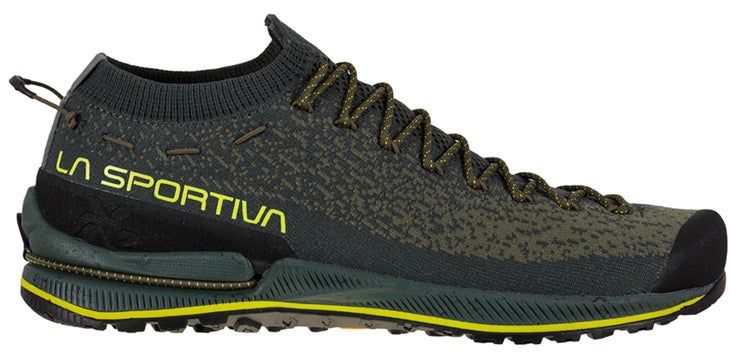
La Sportiva TX2 EVO
Scrambling approaches, climbing up to 5.6, hauling up a long multi-pitch, the TX2 EVO shines for all these situations. “This shoe was one of the closest-fitting I’ve used thanks to a knitted polyester upper that really wraps around the foot and to-the-toe lacing that cranks the whole shoe securely down,” one of our testers wrote. A Vibram Megagrip sole has dot rubber on the whole foot, with a flat section under the asymmetric toe for climbing, inspiring confidence where you need it most.
Price: $125
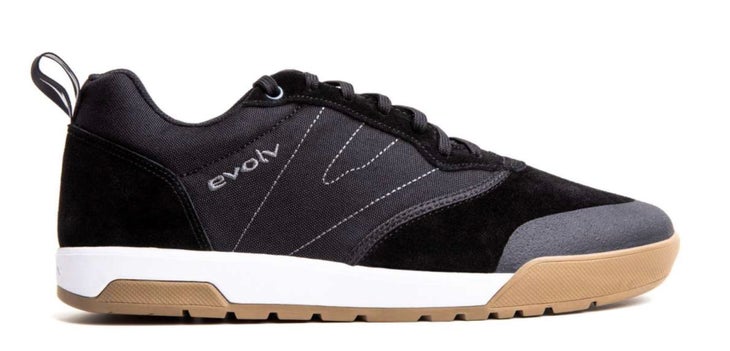
Evolv Rebel
Coming in leather and vegan versions, this light, über-comfy tennie-style approacher went gangbusters on rocky trails, slabs, and techy terrain thanks to the grid-pattern Trax Enduro sole and rubber toecap. The lining is water resistant (and the uppers have been treated), an asset for one of testers during a January approach through a foot of snow. Despite a sleek profile that’s great for urban wear, the shoe also has a welcome dash of burl thanks to its compression-molded EVA midsole.
Price: 115
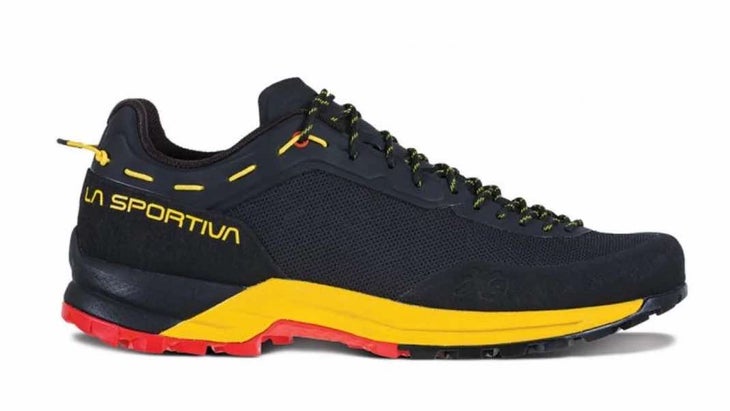 La Sportiva TX Guide
La Sportiva TX Guide